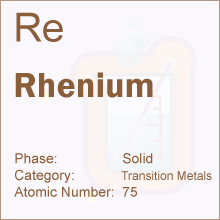 Periodic Table -> Rhenium
Periodic Table -> RheniumRhenium
Rhenium DetailsRhenium Symbol: Re
Rhenium Atomic Number: 75
Rhenium Atomic Weight: 186.2
What is Rhenium?
Rhenium (atomic number 75, symbol Re) is a metal with a silvery-white color, high density, and high melting point. Only platinum, osmium, and iridium have higher densities than rhenium. It is a transition metal that is solid at room temperature and has similar chemical properties to technetium and manganese. The metal was discovered in 1925 by Garl Berg, Walter Noddack, and Ida Tacke-Noddack. This is the last naturally occurring, non-radioactive, and stable chemical element to be isolated.
Properties, Compounds, and Isotopes
Rhenium is a rare metal with good refractory properties similar to niobium, tantalum, molybdenum, and tungsten. It has good resistance to heat, oxidation, and corrosion. The metal has a high melting point of 3170 °C (5738 °F), and only tungsten and carbon have higher melting points than rhenium. It has a hexagonal structure and high tensile strength. The most common oxidation states are +2, + 4, +6, and +7. Rhenium-185 is the only stable isotope. The metal also forms a number of compounds, including sulfides, oxides, oxyhalides, and halides. Rhenium diboride, for example, has hardness that is comparable to compounds such as zirconium diboride, titanium diboride, and silicon carbide. In nature, the element is composed of two isotopes – Re-187 and Re-185.
Sites and Applications
The metal is found in copper ores and the mineral molybdenite, with deposits in New Mexico, Utah, Arizona, and Colorado. Small amounts are present in molybdenum and platinum ores. The metal is usually obtained through copper refining. In addition to platinum ores, the metal is also found in small concentrations in minerals such as gadolinite and columbite. Berg and Noddack were successful in isolating just one gram from more than 650 kg of mineral mass. Chile has the largest deposits of rhenium on a global scale. Deposits are also found in Russia and the United States. The total production amounts to up to 50 tons a year while estimated reserves total about 3,500 tonnes. The major producers operate in Poland, Peru, the U.S., Canada, and Chile.

Rhenium has good resistance to poisoning with phosphorus, sulfur, and nitrogen. It is added to molybdenum and tungsten alloys and used in nickel-based alloys. Alloys are used to produce X-ray anodes and X-ray tubes while the metal is incorporated in plating, jewelry, igniters for flash bulbs, electrodes, thermocouples, electrical contacts, components for missiles, and other products and equipment.
The metal is also used in jet engines and gas turbines. The main reason why it is added to alloys is that it is stable at high temperatures. Other reasons include resistance to arc corrosion and wear and low vapor pressure. It is also used in photoflash lamps, ion gauges, and spectrometers. Filaments for lamps and ovens are produced using rhenium. In addition, the element is used to produce high-octane gasoline in petroleum refineries. Its isotopes also have applications in different fields. Re-186 and Re-188 are used to treat liver cancer while experimental treatment of pancreatic cancer, which is a malignant cancer, involves Re-188. One of its compounds, methylrhenium trioxide, which is a type of inorganic compound and a colorless, volatile solid, is a good catalyst of ethyl diazoacetate reactions and is used in laboratory settings.
Health and Environmental Hazards
When it comes to toxicity, the health effects of exposure are insufficiently studied. Exposure may cause respiratory problems, burns, and skin and eye irritation. Overexposure may cause suffocation and dizziness. Some compounds of rhenium have been tested in laboratory conditions and showed low levels of toxicity. These are rhenium trichloride and potassium perrhenate. The element has no biological role.
You can
link to this page, using the code below:
Periodic Table |
Banks
© ElementsDatabase.com 2015 | Privacy | About | Contact